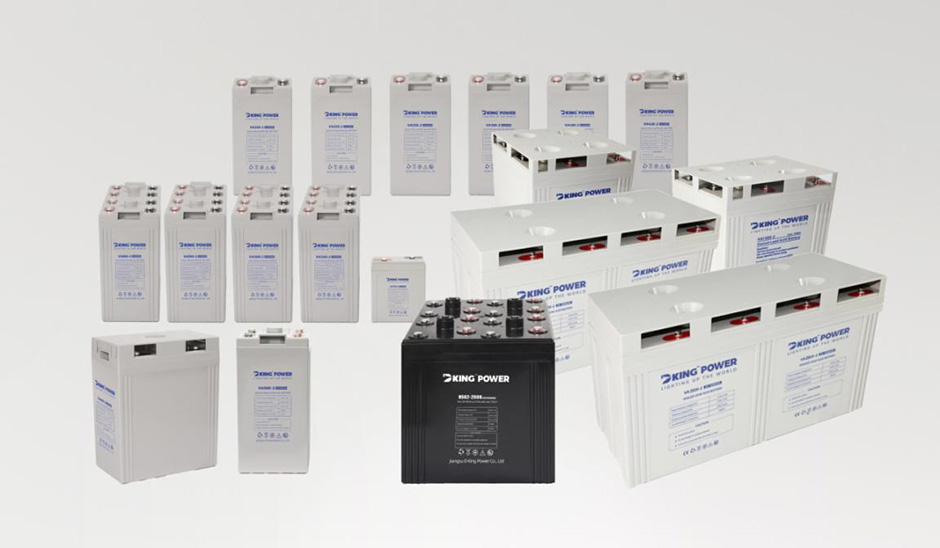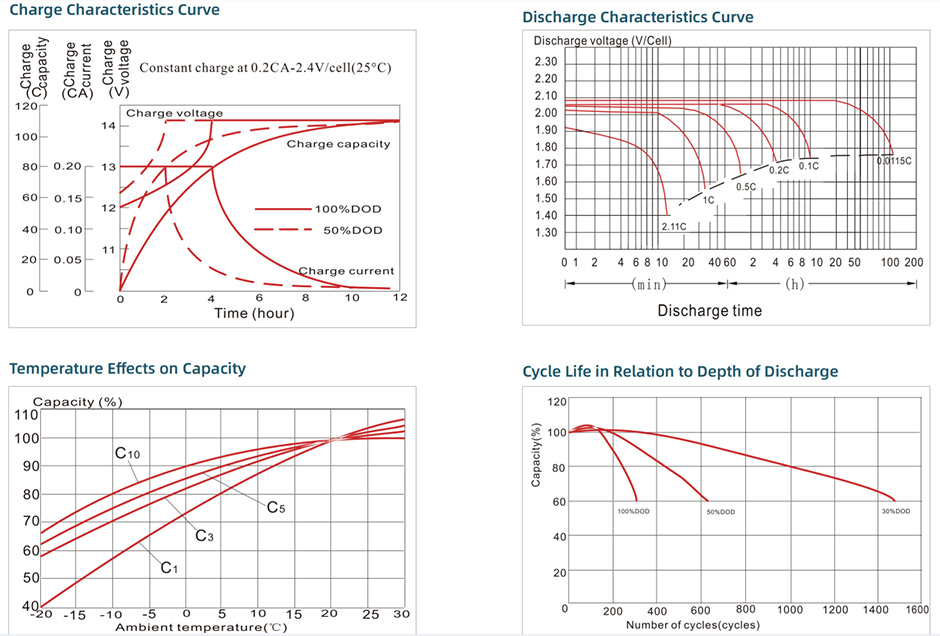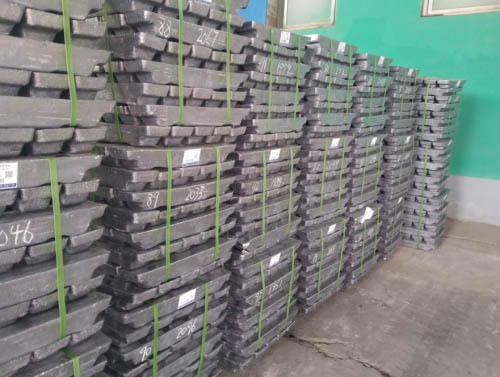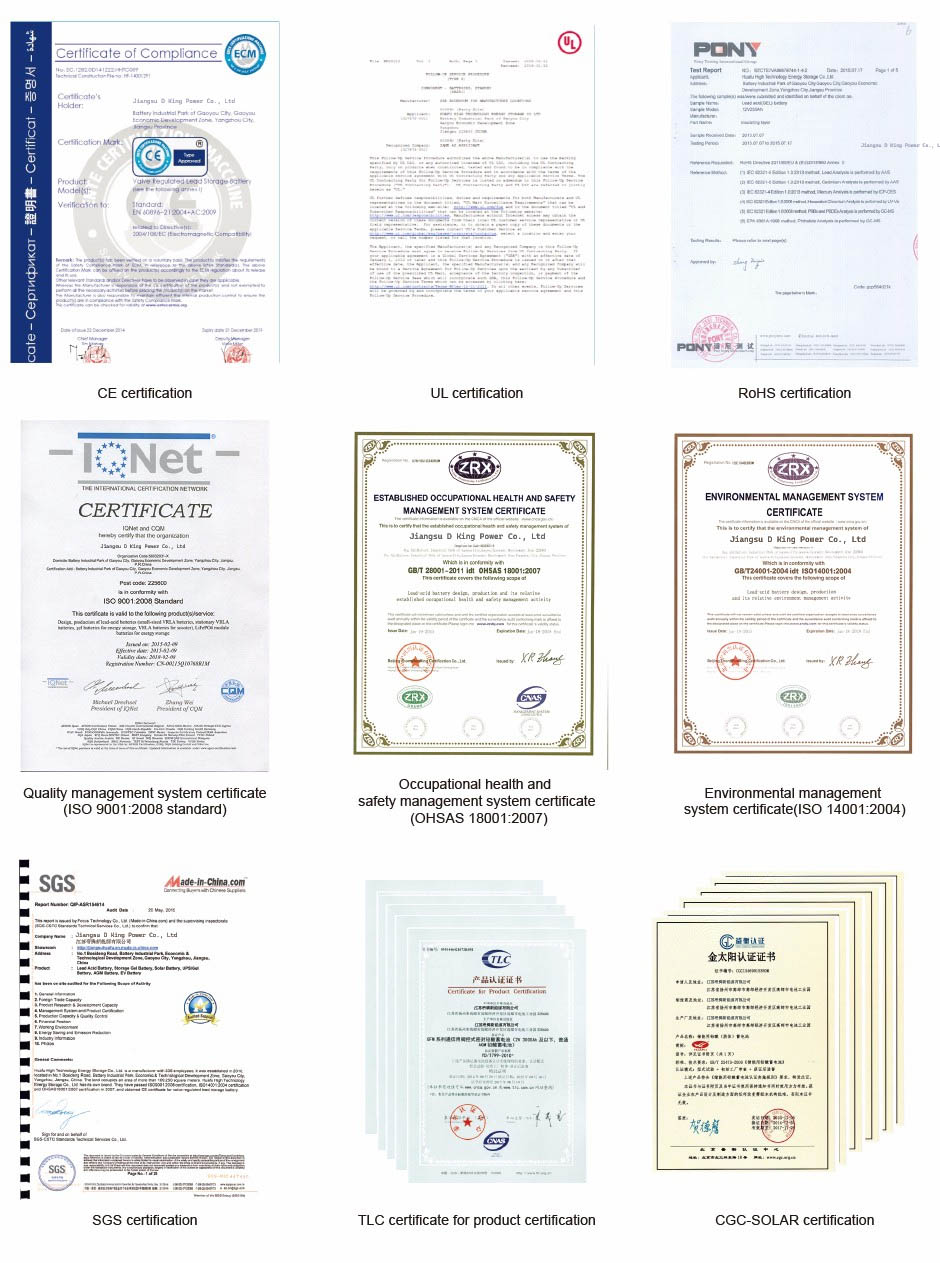DKGB2-900-2V900AH SEALED GEL LEAD ACID BATTERY
Technical Features
1. Charging efficiency: The usage of imported low resistance raw materials and advanced process help make theinternal resistance smaller and the acceptance ability of small current charging stronger.
2. High and low temperature tolerance: Wide temperature range (lead-acid:-25-50 C ,and gel:-35-60 C), suitablefor indoor and outdoor use in varies environments.
3. Long cycle-life: The design life of lead acid and gel series reach to more than 15 and 18 years respectively, forthe arid is corrosion- resistant. and electrolvte is without risk of stratification by using multiple rare-earth alloy ofindependent intellectual property rights, nanoscale fumed silica imported from Germany as base materials, andelectrolyte of nanometer colloid all by independent research and development.
4. Environment-friendly: Cadmium (Cd), which is poisonous and not easy to recycle, does not exist. Acid leakageof gel electrolvte will not happen. The battery operates in safety and environmental protection.
5. Recovery performance: The adoption of special alloys and lead paste formulations make a low self-dischargerate, good deep discharge tolerance, and strong recover capability.

Parameter
|
Model |
Voltage |
Capacity |
Weight |
Size |
|
DKGB2-100 |
2v |
100Ah |
5.3kg |
171*71*205*205mm |
|
DKGB2-200 |
2v |
200Ah |
12.7kg |
171*110*325*364mm |
|
DKGB2-220 |
2v |
220Ah |
13.6kg |
171*110*325*364mm |
|
DKGB2-250 |
2v |
250Ah |
16.6kg |
170*150*355*366mm |
|
DKGB2-300 |
2v |
300Ah |
18.1kg |
170*150*355*366mm |
|
DKGB2-400 |
2v |
400Ah |
25.8kg |
210*171*353*363mm |
|
DKGB2-420 |
2v |
420Ah |
26.5kg |
210*171*353*363mm |
|
DKGB2-450 |
2v |
450Ah |
27.9kg |
241*172*354*365mm |
|
DKGB2-500 |
2v |
500Ah |
29.8kg |
241*172*354*365mm |
|
DKGB2-600 |
2v |
600Ah |
36.2kg |
301*175*355*365mm |
|
DKGB2-800 |
2v |
800Ah |
50.8kg |
410*175*354*365mm |
|
DKGB2-900 |
2v |
900AH |
55.6kg |
474*175*351*365mm |
|
DKGB2-1000 |
2v |
1000Ah |
59.4kg |
474*175*351*365mm |
|
DKGB2-1200 |
2v |
1200Ah |
59.5kg |
474*175*351*365mm |
|
DKGB2-1500 |
2v |
1500Ah |
96.8kg |
400*350*348*382mm |
|
DKGB2-1600 |
2v |
1600Ah |
101.6kg |
400*350*348*382mm |
|
DKGB2-2000 |
2v |
2000Ah |
120.8kg |
490*350*345*382mm |
|
DKGB2-2500 |
2v |
2500Ah |
147kg |
710*350*345*382mm |
|
DKGB2-3000 |
2v |
3000Ah |
185kg |
710*350*345*382mm |

production process

Lead ingot raw materials
Polar plate process
Electrode welding
Assemble process
Sealing process
Filling process
Charging process
Storage and shipping
Certifications

More for reading
In the photovoltaic energy storage system, the role of the battery is to store electric energy. Due to the limited capacity of a single battery, the system usually combines multiple batteries in series and parallel to meet the design voltage level and capacity requirements, so it is also called the battery pack. In the photovoltaic energy storage system, the initial cost of the battery pack and the photovoltaic module is the same, but the service life of the battery pack is lower. The technical parameters of the battery are very important to the system design. During the selection design, pay attention to the key parameters of the battery, such as battery capacity, rated voltage, charge and discharge current, discharge depth, cycle times, etc.
Battery capacity
The capacity of the battery is determined by the number of active substances in the battery, which is usually expressed in ampere hour Ah or milliampere hour mAh. For example, the nominal capacity of 250Ah (10hr, 1.80V/cell, 25 ℃) refers to the capacity released when the voltage of a single battery drops to 1.80V by discharging at 25A for 10 hours at 25 ℃.
The energy of the battery refers to the electrical energy that can be given by the battery under a certain discharge system, usually expressed in watt hours (Wh). The energy of the battery is divided into theoretical energy and actual energy: for example, for a 12V250Ah battery, the theoretical energy is 12 * 250=3000Wh, that is, 3 kilowatt hours, indicating the amount of electricity that the battery can store. If the discharge depth is 70%, the actual energy is 3000 * 70%=2100 Wh, that is, 2.1 kilowatt hours, which is the amount of electricity that can be used.
Rated voltage
The potential difference between the positive and negative electrodes of the battery is called the rated voltage of the battery. The rated voltage of common lead-acid batteries is 2V, 6V and 12V. The single lead-acid battery is 2V, and the 12V battery is composed of six single batteries in series.
The actual voltage of the battery is not a constant value. The voltage is high when the battery is unloaded, but it will decrease when the battery is loaded. When the battery is suddenly discharged with a large current, the voltage will also drop suddenly. There is an approximate linear relationship between the battery voltage and the residual power. Only when the battery is unloaded, this simple relationship exists. When the load is applied, the battery voltage will be distorted due to the voltage drop caused by the internal impedance of the battery.
Maximum charging and discharging current
The battery is bidirectional and has two states, charging and discharging. The current is limited. The maximum charging and discharging currents are different for different batteries. The charging current of the battery is generally expressed as a multiple of the battery capacity C. For example, if the battery capacity C=100Ah, the charging current is 0.15 C × 100=15A。
Discharge depth and cycle life
During the use of the battery, the percentage of the capacity released by the battery in its rated capacity is called the discharge depth. The battery life is closely related to the discharge depth. The deeper the discharge depth is, the shorter the charging life is.
The battery undergoes a charge and discharge, which is called a cycle (one cycle). Under certain discharge conditions, the number of cycles that the battery can withstand before working to a specified capacity is called cycle life.
When the battery discharge depth is 10%~30%, it is shallow cycle discharge; The discharge depth of 40%~70% is medium cycle discharge; The discharge depth of 80%~90% is deep cycle discharge. The deeper the daily discharge depth of the battery during long-term operation, the shorter the battery life. The shallower the discharge depth, the longer the battery life.
At present, the common storage battery of photovoltaic energy storage system is electrochemical energy storage, which uses chemical elements as energy storage medium. The charging and discharging process is accompanied by the chemical reaction or change of the energy storage medium. It mainly includes lead acid battery, liquid flow battery, sodium sulfur battery, lithium ion battery, etc. At present, lithium battery and lead battery are mainly used.














